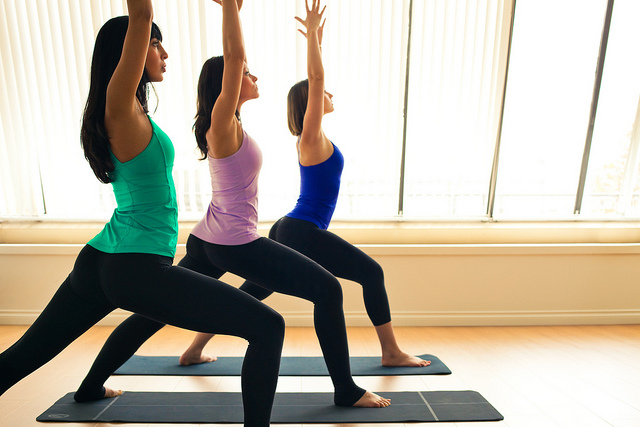
“Don’t let your mind bully your body into believing it must carry the burden of its worries.” ~Astrid Alauda
I don’t believe in the mind/body divide. I can see the gap between them, the one that we put there, but I have little faith in it. In the past month, I’ve learned that in order to live fully, I need to overcome that self-imposed gap.
We all have different mental, emotional, and physical capacities. You could probably run a 5k race, but I’d struggle to even walk it. I know I can work through some of the most difficult decisions, like knowing when to end my pets’ suffering, but you might find that extremely hard to come to terms with.
The thing that we have in common, though, is that we all work at different levels, and whether we choose to believe it or not, our minds and bodies sit together, with each of us.
I took up yoga last month, and I love it. The benefits of getting out for an hour to relax are endless, and I’ve started taking the practice home with me to reap these benefits throughout my week.
I’m headstrong, so I push myself a bit further than I should. Sometimes I go too far and I exhaust myself, or I stretch beyond what my body can manage and end up with extra painful muscles for days.
What’s going on here? It’s that gap between my mind and body.
My mind drags my body places it doesn’t want to go, and I feel sorry for it having to suffer that.
I’ve been practicing a shoulder stand for a few weeks now. At first, it was nearly impossible to get my legs close to my chest without the posture collapsing, or should I say, me collapsing into a heap.
I’d visualize the posture all the time in my head so I should have been able to pull it off, no problem, but I couldn’t. Why?
My body, my back specifically, isn’t strong enough yet to straighten and hold that posture. I can barely sit or stand up straight in my everyday life for long periods of time without getting fatigued. The muscles are underdeveloped, the ligaments and tendons not substantial enough to hold my bones steady.
And all the while, my crazy mind is hurtling ahead saying, “Come on, come on! Let’s go!”
In order for me to achieve the posture, I need to slow my mind down and train my body; both need lessons in giving and receiving information about performing a shoulder stand. This can only be done through cooperative practice.
It doesn’t matter if you’re practicing yoga, perseverance, or patience—you have to practice. You have to go through the motions, learning your limits as you do, and you have to experience it in both your mind and body.
You’re giving a speech, so you should speak those words out loud so you know what they sound like, so you know how to make adjustments. You’re taking a driving test, so you have to attend the lessons and study the rules in order to drive safely and pass that test.
Practice is realizing you can’t control what you will experience by over-thinking, overanalyzing, and forcing your will. You simply have to show up and be there, in both mind and body, allowing for an integrated experience.
When your mind and body aren’t on the same page, you can end up hurting yourself, and you’ll likely set yourself up for frustration, stress, and a persistent sense of disappointment with what is.
Now when I perform a shoulder stand, my mind knows not to run away with itself and leave my body to struggle. My mind communicates with my spine and my muscles, and together they ease their way, inch by inch, into the posture—but only as far as my body can manage.
As my mind has learned to listen and cooperate, my body has learned to speak and become confident, stronger.
With each practice, I can feel the effects of closing the gap between my mind and body. My back feels stronger and it becomes a little straighter every time. My breathing is slow and open. My shoulders feel heavy and support my weight, just like my feet do. My thoughts are focused and clear.
The asana brings my mind and body together. Separate, they’re useless, but together they’re dedicated and powerful.
The gaps between our minds and bodies are evident in all we do. We walk without thinking, and think without an awareness of our physicality. Have you ever bumped into some while out shopping? Was your mind elsewhere when you trod on your cat?
We can all learn to slowly draw ourselves together; become aware of how our thoughts and actions might not always match up. This isn’t a battle. The fight is where our brain and body try to tear away from one another, and try to transcend each other’s company.
Mindful practice of even the most basic tasks like driving, cleaning up, and walking is reconciliation—our opportunity to take hold of our minds and bodies, turn them toward one another, and say “Now, kiss and make up.” There is no war within us, only the blindness to our states and conditions.
Maybe there will always be a slight space between mind and body. A bit of difference is fine. Think of it as space to think and explore, but remember that a space doesn’t have to be a gorge.
To be strong isn’t to have an interminable will or to have a muscular physique; it isn’t about preferring one to the other, mind over matter, prowess over intelligence.
Being strong is sensing your gaps and working with them, drawing them closer, bridging them, and learning from them.
Photo by lululemon athletica
About Sam Russell
Sam Russell is a young writer from the southeastern corner of the UK. He’s a cynic by nature trying to prove that cynics can be happy and positive, too. Visit his blog at http://cackhanded.wordpress.com/.













 Though I run this site, it is not mine. It's ours. It's not about me. It's about us. Your stories and your wisdom are just as meaningful as mine.
Though I run this site, it is not mine. It's ours. It's not about me. It's about us. Your stories and your wisdom are just as meaningful as mine.
Nice Article!
http://www.cataniapilates.it
[…] by Sam Russell/TinyBuddha.com […]
Mind and body betting in together in present tense is one good way to reduce stress. Nothing I knew this time. GOod one.
wonderful post and reminder. I’ve been sick 3 times in 3 weeks (infection and now a cold). I need to listen to the message my body is trying to send my mind.
Thanks for this post!! I know I have a very difficult time with the way I treat my body. It just takes me so long to accept and deal with the physical limitations I have. Sometimes I feel like acceptance is too similar to pity and othertimes I just don’t want to deal with it because other people don’t have to. There is definately a gap between mind and body for me. Thanks for reminding me to work on that!
I’m excited for you that you started yoga. Still trying to overcome the fear / find the cash myself. 🙂
Love this. Thank you Sam 🙂 Such a beautiful and wise perspective! Well done.
Wonderful article :)! I can totally relate. When i fist started yoga i, too, abused my body by overstretching it, after a while i realized that I’m loosing the whole point, respecting my body, accepting its limits and relaxing, as well stated “Stress is caused by being ‘here,’
but wanting to be ‘there.’” -Eckhart Tolleand. Since then i stay at my own level, relax and keep the posture for a minimum of one minute, this way i show care for my body, meditate and be present at each moment, and of course my flexibility and strength have raised significantly, more than i was dreaming at first.
I’ve had trouble with the same thing over the years. Believing you can do something ‘impossible’ is great but it does have to have a basis in reality. Peter Ralston speaks about this, and a really great book to read is “Zen Body Being”, and it has a lot of correlation with Buddhist teachings of Right Intention, Right Practice, etc.
Here’s a link to his most recent work “The Book of Not Knowing” http://snurl.com/26px1w heavy, but well worth your time ^_^
[…] Integrating Mind and Body: Be Present, Reduce Stress | Tiny Buddha … […]
[…] you notice those mental stories spinning, stop and consciously shift from being in your mind to being in your body. The fastest and most effective way I know to do that is to breathe deeply and consciously. Notice, […]
[…] you notice those mental stories spinning, stop and consciously shift from being in your mind to being in your body. The fastest and most effective way I know to do that is to breathe deeply and consciously. Notice, […]
Fabulous article I must say. Stress has now become a part of our life. This article is really a great help to get off from it.